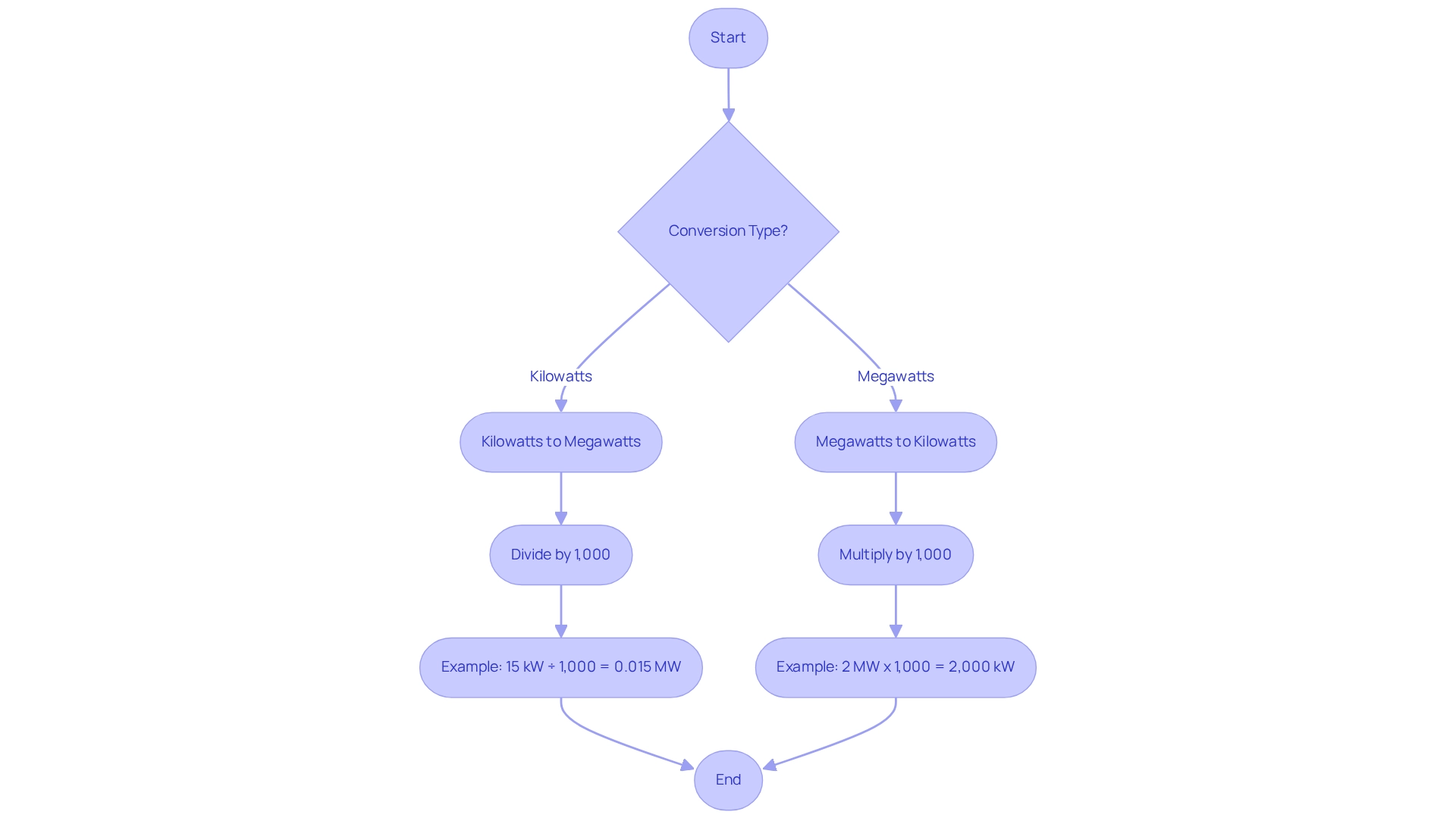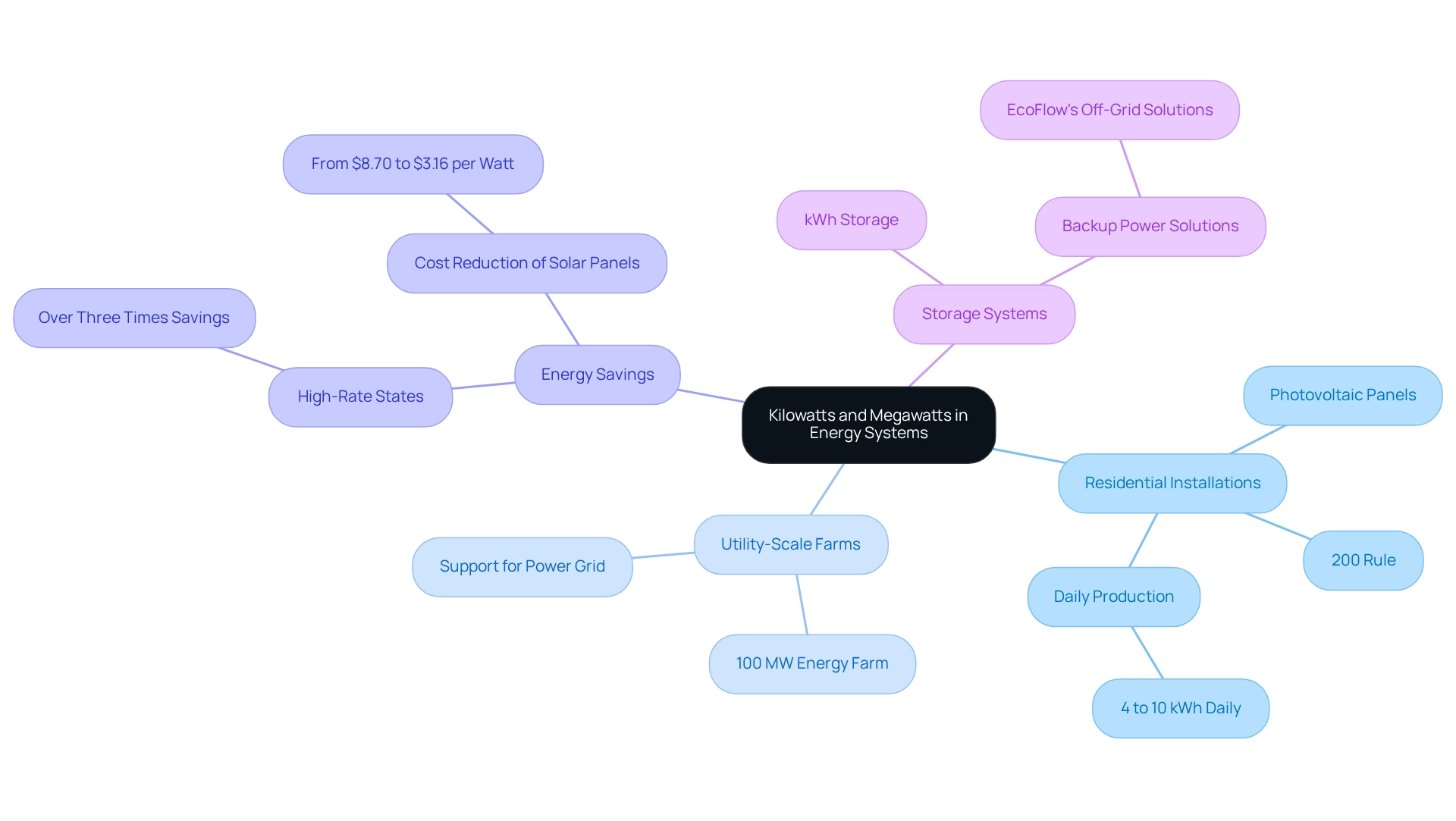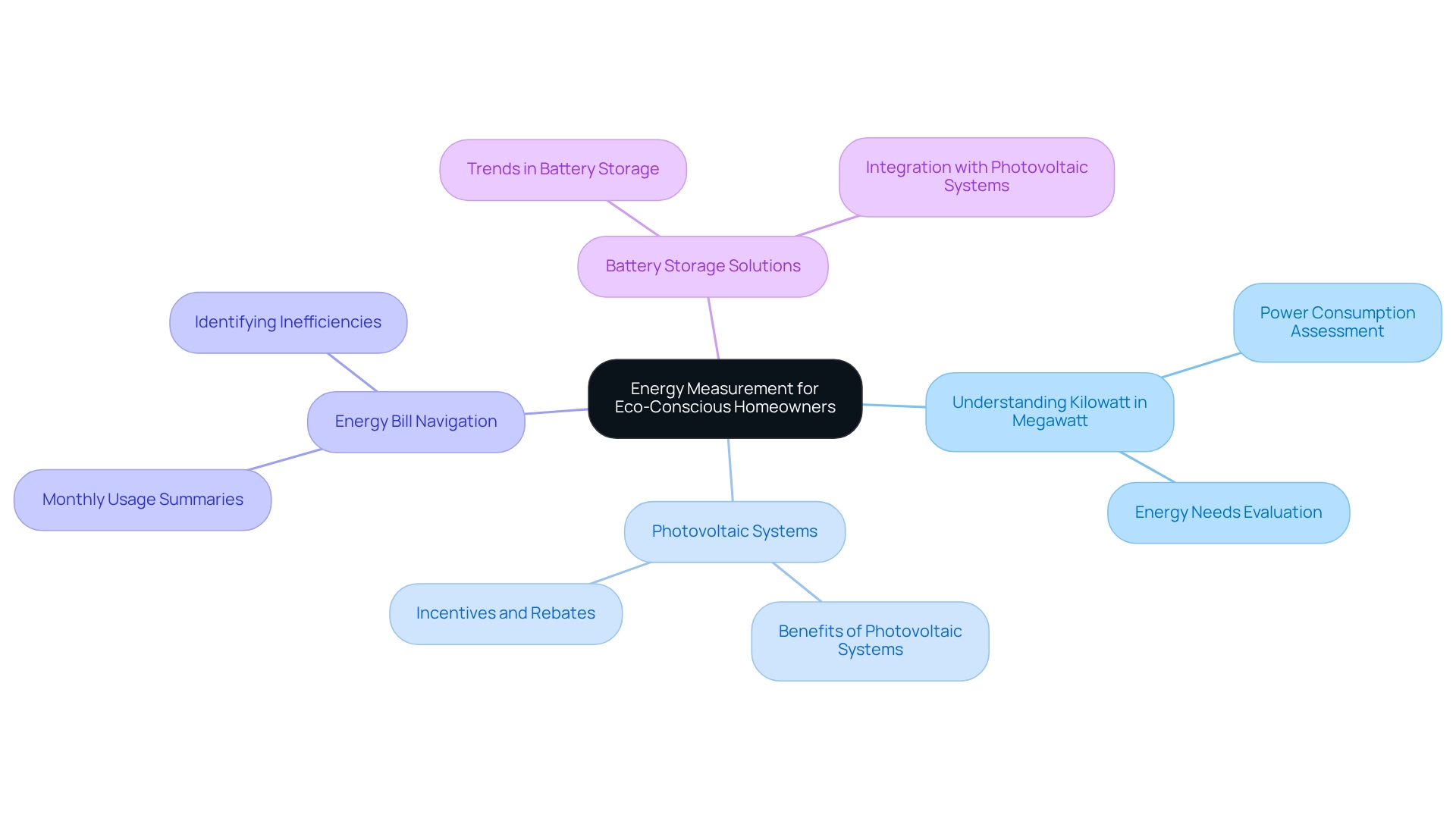Overview
We understand that many homeowners are concerned about rising energy bills and the impact on their budgets. It’s essential to grasp the basics of energy measurement, such as kilowatts and megawatts, to make informed decisions about energy consumption and generation. A kilowatt is a unit of power equivalent to 1,000 watts, while a megawatt represents 1,000 kilowatts or 1 million watts. By understanding these concepts, you can optimize your use of photovoltaic systems, paving the way towards energy independence and sustainability.
Imagine the benefits of harnessing solar energy: not only can you reduce your reliance on grid electricity, but you can also lower your energy costs significantly. It’s common to feel overwhelmed by the choices available, but remember, together we can navigate this journey towards a more sustainable future. By making these informed choices, you empower yourself to take control of your energy habits and contribute to a healthier planet.
If you’re ready to explore how solar energy can transform your home and finances, let’s work towards a brighter, more sustainable future together. Your journey towards energy efficiency starts here, and we are here to support you every step of the way.
Introduction
In the ever-changing world of energy consumption, we understand that many homeowners are concerned about rising energy bills and the impact on their budgets. Grasping key measurements like kilowatts and megawatts is essential, especially for those considering the switch to solar energy.
- A kilowatt, which represents 1,000 watts,
- Its larger counterpart, the megawatt, equal to 1 million watts,
are fundamental units that can help you make informed decisions about energy production and efficiency. As eco-conscious individuals, you seek to optimize your investments in solar systems.
By understanding these concepts, not only can you evaluate your energy needs more effectively, but you can also enhance your potential for savings. With the rise of solar technology and a growing interest in sustainable living, you have a unique opportunity to harness these measurements for a greener future.
Together, let’s explore how we can make this journey towards energy independence a reality.
Define Kilowatt and Megawatt: Key Concepts in Energy Measurement
As a homeowner, you might be feeling the weight of rising energy bills. A kilowatt in megawatt is a unit of power that is equivalent to 1,000 watts, which quantifies the rate of transfer of power. A megawatt (MW), on the other hand, is equivalent to 1,000 kilowatt in megawatt or 1 million watts. Understanding these units is essential, especially as you explore sustainable solutions like photovoltaic systems, which are becoming increasingly popular among environmentally conscious residents in Long Beach.
Imagine a standard residential photovoltaic panel arrangement rated at 5 kW; this means it can generate 5,000 watts of energy under ideal conditions. In contrast, larger power plants may be rated in megawatts, indicating their capacity to produce substantial amounts of electricity. By grasping these measurements, you can directly link them to efficiency and potential cost reductions for your home.
Current statistics show that the average kilowatt rating for residential photovoltaic panel setups in California is rising, reflecting the growing interest in renewable energy alternatives. The cost of installing ranges from $5,400 to $18,000, and as a homeowner, you may be eager to optimize your investment. Understanding how kilowatt in megawatt ratings influence your energy consumption and savings can empower you to make informed decisions.
Consider this: a household utilizing a 5 kW photovoltaic system can significantly reduce its reliance on grid electricity. With advancements in renewable technology, some panels can remain functional for over 40 years at more than 80% efficiency. Additionally, the high recyclability rate of photovoltaic materials—between 90% and 97%—underscores the sustainability of this energy source. It’s a compelling choice for eco-conscious homeowners like you who wish to enhance energy efficiency and contribute to a sustainable future.
For more detailed insights, we understand that navigating this journey can be overwhelming. Renters in Long Beach can refer to user manuals and guides on photovoltaic panel functionality and battery storage solutions. Together, we can explore the best options for your energy needs and work towards a brighter, more sustainable future.
Convert Kilowatts to Megawatts: Step-by-Step Guide
We understand that managing energy bills can be a source of concern for many homeowners. To ease your worries, let’s explore how converting kilowatt in megawatt can help you better understand your energy usage. Simply divide the number of kilowatts in megawatt by 1,000 to convert the measurement. For example, if you have a solar setup rated at 15 kW, the conversion from kilowatt in megawatt would be:
- 15 kW ÷ 1,000 = 0.015 MW.
This straightforward mathematical connection is essential for comprehending the scale of power production and consumption in both residential and commercial environments.
Conversely, if you ever need to convert megawatts back to kilowatt in megawatt, it’s simply a matter of multiplying by 1,000. For instance,
- 2 MW would equal 2,000 kW.
By grasping these conversions, you can gain a clearer perspective on your energy consumption and the potential benefits of solar energy. Together, we can work towards energy independence, ensuring that your home is not only more efficient but also more sustainable.
If you have any questions or need assistance in navigating these conversions, please feel free to reach out. Your journey towards a more energy-efficient home is important to us, and we’re here to help.
Explore Real-World Applications: Kilowatts and Megawatts in Energy Systems
Understanding your energy bills can be overwhelming, but knowing the conversion of kilowatt in megawatt is essential for grasping the output of power sources. In residential settings, typically generate power measured in kilowatt in megawatt, while larger utility-scale farms are rated in megawatts. This distinction is crucial for homeowners like you, especially when considering the potential savings from photovoltaic installations under the 200% rule, which allows for increased capacity. For instance, a 5 kW photovoltaic installation can lead to significant reductions in electricity expenses, while a 100 MW energy farm has the capacity to supply power to thousands of homes.
Many home photovoltaic installations vary in their power production, often generating between 4 to 10 kWh daily, influenced by factors such as location and installation size. This output can translate into considerable savings, particularly in areas with high electricity costs, where photovoltaic systems can provide more than three times the savings compared to those in regions with lower rates.
Storage systems, like photovoltaic batteries, are rated in kilowatt-hours (kWh), indicating how much power they can store for future use. This feature is especially helpful during outages, allowing you to keep your home powered even when the grid is down. For example, EcoFlow’s off-grid solutions combine portable power stations with photovoltaic panels, enabling users to maximize output and savings while ensuring they have backup power when needed.
Moreover, understanding the conversion of kilowatt in megawatt measurements is vital for evaluating the impact of photovoltaic systems. Utility-scale photovoltaic farms, often rated in megawatts, play a significant role in supporting the power grid, showcasing the scalability of this technology. As highlighted in recent case studies, property owners have benefited from under the 200% rule, allowing them to harness more power and achieve greater savings.
We believe that as you consider transitioning to renewable sources, grasping these concepts will empower you to make informed choices about your energy use and savings. Together, we can work towards a more sustainable future.
Empower Eco-Conscious Homeowners: The Importance of Energy Measurement
For environmentally-conscious homeowners, understanding the principles of kilowatt in megawatt is vital for making informed choices about power usage and sustainability. By measuring power consumption in kilowatts, you can accurately assess and the advantages of photovoltaic systems. This knowledge empowers you to select appropriately sized photovoltaic systems and improve , ultimately contributing to a reduced carbon footprint.
We understand that navigating energy bills can be overwhelming. However, grasping power measurements enables you to take full advantage of available incentives and rebates for photovoltaic systems, making the transition to sustainable resources both achievable and financially rewarding. Statistics reveal that most utility providers offer comprehensive monthly summaries of usage, which can help you identify inefficiencies and guide you in optimizing your consumption.
A significant case study shows that 92% of residential installers now provide battery storage installation, highlighting a growing trend towards integrating battery solutions with photovoltaic systems. This impressive adoption rate underscores the increasing demand for backup power sources among homeowners, enhancing the overall value of solar installations. By understanding kilowatt in megawatt, you can make informed decisions that lead to substantial energy savings and a more sustainable lifestyle. Together, let’s work towards a greener future.
Conclusion
We understand that navigating the complexities of energy consumption can be overwhelming, especially when it comes to managing those monthly energy bills. Understanding kilowatts and megawatts is essential for homeowners like you, as it empowers you to take control of your energy needs and explore sustainable options like solar energy systems.
Kilowatts represent the rate of energy transfer, while megawatts signify larger energy outputs, which are crucial for evaluating the performance of both residential solar installations and utility-scale energy solutions. By grasping these fundamental measurements, you can make informed decisions about optimizing your solar investments and enhancing your potential for savings.
The conversion between kilowatts and megawatts is straightforward, providing clarity on energy production scales that can significantly impact your savings. This knowledge is particularly valuable as you assess the benefits of solar technology, especially in areas where electricity costs are high and substantial savings can be achieved. Real-world applications demonstrate that understanding these metrics not only empowers you to maximize your energy efficiency but also enables you to take advantage of available incentives for solar installations.
Ultimately, embracing the concepts of kilowatts and megawatts paves the way for a more sustainable lifestyle. By accurately measuring your energy consumption and production, you can reduce your carbon footprint and contribute to a greener future. As the transition to renewable energy continues to grow, the ability to navigate these energy measurements will allow you to make strategic choices that benefit both your finances and the environment.
Together, we can work towards a brighter, more sustainable future. So, let’s take this journey together—contact us today to explore how we can support you in achieving energy independence.





